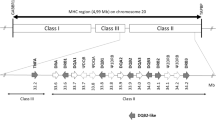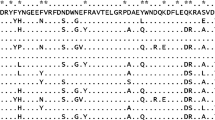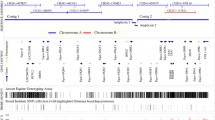Abstract
The polymorphism of major histocompatibility complex (MHC) class II DQ and DR genes in five common equine leukocyte antigen (ELA) haplotypes was determined through sequencing of mRNA transcripts isolated from lymphocytes of eight ELA homozygous horses. Ten expressed MHC class II genes were detected in horses of the ELA-A3 haplotype carried by the donor horses of the equine bacterial artificial chromosome (BAC) library and the reference genome sequence: four DR genes and six DQ genes. The other four ELA haplotypes contained at least eight expressed polymorphic MHC class II loci. Next generation sequencing (NGS) of genomic DNA of these four MHC haplotypes revealed stop codons in the DQA3 gene in the ELA-A2, ELA-A5, and ELA-A9 haplotypes. Few NGS reads were obtained for the other MHC class II genes that were not amplified in these horses. The amino acid sequences across haplotypes contained locus-specific residues, and the locus clusters produced by phylogenetic analysis were well supported. The MHC class II alleles within the five tested haplotypes were largely non-overlapping between haplotypes. The complement of equine MHC class II DQ and DR genes appears to be well conserved between haplotypes, in contrast to the recently described variation in class I gene loci between equine MHC haplotypes. The identification of allelic series of equine MHC class II loci will aid comparative studies of mammalian MHC conservation and evolution and may also help to interpret associations between the equine MHC class II region and diseases of the horse.






Similar content being viewed by others
Abbreviations
- BAC:
-
Bacterial artificial chromosome
- ELA:
-
Equine leukocyte antigen
- MHC:
-
Major histocompatibility complex
- UTR:
-
Untranslated region
- WGS:
-
Whole genome sequence
- NGS:
-
Next generation sequencing
References
Albright-Fraser DG, Reid R, Gerber V, Bailey E (1996) Polymorphism of DRA among equids. Immunogenetics 43:315–317
Andersson LS, Swinburne JE, Meadows JR, Brostrom H, Eriksson S, Fikse WF, Frey R, Sundquist M, Tseng CT, Mikko S, Lindgren G (2012) The same ELA class II risk factors confer equine insect bite hypersensitivity in two distinct populations. Immunogenetics 64:201–208
Antczak DF, Bailey E, Barger B, Guerin G, Lazary S, McClure J, Mottironi VD, Symons R, Templeton J, Varewyck H (1986) Joint report of the Third International Workshop on Lymphocyte Alloantigens of the Horse, Kennett Square, Pennsylvania, 25-27 April 1984. Anim Genet 17:363–373
Antczak DF, Bright SM, Remick LH, Bauman BE (1982) Lymphocyte alloantigens of the horse. I. Serologic and genetic studies. Tissue Antigens 20:172–187
Antczak DF, Miller JM, Remick LH (1984) Lymphocyte alloantigens of the horse. II. Antibodies to ELA antigens produced during equine pregnancy. J Reprod Immunol 6:283–297
Barbis DP, Maher JK, Stanek J, Klaunberg BA, Antczak DF (1994) Horse cDNA clones encoding two MHC class I genes. Immunogenetics 40:163
Brinkmeyer-Langford CL, Cai JJ, Gill CA, Skow LC (2013) Microsatellite variation in the equine MHC. Anim Genet 44:267–275
Brown JJ, Thomson W, Clegg P, Eyre S, Kennedy LJ, Matthews J, Carter S, Ollier WE (2004) Polymorphisms of the equine major histocompatibility complex class II DRA locus. Tissue Antigens 64:173–179
Brunsberg U, Edfors-Lilja I, Andersson L, Gustafsson K (1996) Structure and organization of pig MHC class II DRB genes: evidence for genetic exchange between loci. Immunogenetics 44:1–8
Carpenter S, Baker JM, Bacon SJ, Hopman T, Maher J, Ellis SA, Antczak DF (2001) Molecular and functional characterization of genes encoding horse MHC class I antigens. Immunogenetics 53:802–809
Crepaldi T, Crump A, Newman M, Ferrone S, Antczak DF (1986) Equine T lymphocytes express MHC class II antigens. J Immunogenet 13:349–360
Diaz S, Giovambattista G, Peral-Garcia P (2005) Polymorphisms of the upstream regulatory region of the major histocompatibility complex DRB genes in domestic horses. Int J Immunogenet 32:91–98
Ellis SA, Bontrop RE, Antczak DF, Ballingall K, Davies CJ, Kaufman J, Kennedy LJ, Robinson J, Smith DM, Stear MJ et al (2006) ISAG/IUIS-VIC comparative MHC nomenclature committee report, 2005. Immunogenetics 57:953–958
Fraser DG, Bailey E (1996) Demonstration of three DRB loci in a domestic horse family. Immunogenetics 44:441–445
Fraser DG, Bailey E (1998) Polymorphism and multiple loci for the horse DQA gene. Immunogenetics 47:487–490
Fritz KL, Kaese HJ, Valberg SJ, Hendrickson JA, Rendahl AK, Bellone RR, Dynes KM, Wagner ML, Lucio MA, Cuomo FM et al (2014) Genetic risk factors for insidious equine recurrent uveitis in Appaloosa horses. Anim Genet 45:392–399
Gustafson AL, Tallmadge RL, Ramlachan N, Miller D, Bird H, Antczak DF, Raudsepp T, Chowdhary BP, Skow LC (2003) An ordered BAC contig map of the equine major histocompatibility complex. Cytogenet Genome Res 102:189–195
Hickford JG, Zhou H, Slow S, Fang Q (2004) Diversity of the ovine DQA2 gene. J Anim Sci 82:1553–1563
Hogstrand K, Bohme J (1999) Gene conversion can create new MHC alleles. Immunol Rev 167:305–317
Horin P, Matiasovic J (2002) A second locus and new alleles in the major histocompatibility complex class II (ELA-DQB) region in the horse. Anim Genet 33:196–200
Janova E, Matiasovic J, Vahala J, Vodicka R, Van Dyk E, Horin P (2009) Polymorphism and selection in the major histocompatibility complex DRA and DQA genes in the family Equidae. Immunogenetics 61:513–527
Kamath PL, Getz WM (2011) Adaptive molecular evolution of the major histocompatibility complex genes, DRA and DQA, in the genus Equus. BMC Evol Biol 11:128
Kambayashi T, Laufer TM (2014) Atypical MHC class II-expressing antigen-presenting cells: can anything replace a dendritic cell? Nat Rev Immunol 14:719–730
Kelley J, Walter L, Trowsdale J (2005) Comparative genomics of major histocompatibility complexes. Immunogenetics 56:683–695
Klumplerova M, Vychodilova L, Bobrova O, Cvanova M, Futas J, Janova E, Vyskocil M, Vrtkova I, Putnova L, Dusek L et al (2013) Major histocompatibility complex and other allergy-related candidate genes associated with insect bite hypersensitivity in Icelandic horses. Mol Biol Rep 40:3333–3340
Lazary S, Antczak DF, Bailey E, Bell TK, Bernoco D, Byrns G, McClure JJ (1988) Joint Report of the Fifth International Workshop on Lymphocyte Alloantigens of the Horse, Baton Rouge, Louisiana, 31 October-1 November 1987. Anim Genet 19:447–456
Lazary S, Bullen S, Muller J, Kovacs G, Bodo I, Hockenjos P, De Weck AL (1980) Equine leukocyte antigen system. II. Serological and mixed lymphocyte reactivity studies in families. Transplantation 30:210–215
Lazary S, Dubath ML, Luder C, Gerber H (1986) Equine leucocyte antigen system. IV. Recombination within the major histocompatibility complex (MHC). J Immunogenet 13:315–325
Lazary S, Marti E, Szalai G, Gaillard C, Gerber H (1994) Studies on the frequency and associations of equine leucocyte antigens in sarcoid and summer dermatitis. Anim Genet 25(Suppl 1):75–80
Li H, Durbin R (2010) Fast and accurate long-read alignment with Burrows-Wheeler transform. Bioinformatics 26:589–595
Li H, Handsaker B, Wysoker A, Fennell T, Ruan J, Homer N, Marth G, Abecasis G, Durbin R, Genome Project Data Processing, S (2009) The sequence alignment/map format and SAMtools. Bioinformatics 25:2078–2079
Minias P, Bateson ZW, Whittingham LA, Johnson JA, Oyler-McCance S, Dunn PO (2016) Contrasting evolutionary histories of MHC class I and class II loci in grouse-effects of selection and gene conversion. Heredity (Edinb) 116:466–476
Nasir L, Ndiaye M, Seely C, Stear MJ (1997) Sequence polymorphism in the bovine major histocompatibility complex DQB loci. Anim Genet 28:441–445
Saitou N, Nei M (1987) The neighbor-joining method: a new method for reconstructing phylogenetic trees. Mol Biol Evol 4:406–425
Staiger EA, Tseng CT, Miller D, Cassano JM, Nasir L, Garrick D, Brooks SA, Antczak DF (2016) Host genetic influence on papillomavirus-induced tumors in the horse. Inte J Cancer J Int du Cancer 139:784–792
Szalai G, Antczak DF, Gerber H, Lazary S (1994a) Molecular cloning and characterization of horse DQA cDNA. Immunogenetics 40:457
Szalai G, Antczak DF, Gerber H, Lazary S (1994b) Molecular cloning and characterization of horse DQB cDNA. Immunogenetics 40:458
Tallmadge RL, Campbell JA, Miller DC, Antczak DF (2010) Analysis of MHC class I genes across horse MHC haplotypes. Immunogenetics 62:159–172
Tallmadge RL, Lear TL, Antczak DF (2005) Genomic characterization of MHC class I genes of the horse. Immunogenetics 57:763–774
Tamura K, Dudley J, Nei M, Kumar S (2007) MEGA4: molecular evolutionary genetics analysis (MEGA) software version 4.0. Mol Biol Evol 24:1596–1599
Trowsdale J (2011) The MHC, disease and selection. Immunol Lett 137:1–8
Tseng CT, Miller D, Cassano J, Bailey E, Antczak DF (2010) Identification of equine major histocompatibility complex haplotypes using polymorphic microsatellites. Anim Genet 41(Suppl 2):150–153
Villegas-Castagnasso EE, Diaz S, Giovambattista G, Dulout FN, Peral-Garcia P (2003) Analysis of ELA-DQB exon 2 polymorphism in Argentine Creole horses by PCR-RFLP and PCR-SSCP. J Vet Med A Physiol Pathol Clin Med 50:280–285
Vranova M, Alloggio I, Qablan M, Vyskocil M, Baumeisterova A, Sloboda M, Putnova L, Vrtkova I, Modry D, Horin P (2011) Genetic diversity of the class II major histocompatibility DRA locus in European, Asiatic and African domestic donkeys. Infect Genet Evol 11:1136–1141
Wade CM, Giulotto E, Sigurdsson S, Zoli M, Gnerre S, Imsland F, Lear TL, Adelson DL, Bailey E, Bellone RR et al (2009) Genome sequence, comparative analysis, and population genetics of the domestic horse. Science 326:865–867
Yuhki N, Beck T, Stephens R, Neelam B, O’Brien SJ (2007) Comparative genomic structure of human, dog, and cat MHC: HLA, DLA, and FLA. J Hered 98:390–399
Yuhki N, Beck T, Stephens RM, Nishigaki Y, Newmann K, O’Brien SJ (2003) Comparative genome organization of human, murine, and feline MHC class II region. Genome Res 13:1169–1179
Acknowledgements
This research was conducted with support from US National Institutes of Health grant HD-049545, the Harry M. Zweig Memorial Fund for Equine Research, the Dorothy Russell Havemeyer Foundation, Inc., and the Morris Animal Foundation grant D13EQ-026. This study was made possible in part by NPRP Grant 6-1303-4-023 from the Qatar National Research Fund (a member of Qatar Foundation). The findings achieved, herein, are solely the responsibility of the authors. We would like to thank Jim Hardy, Scott Hoffay, and Emily Silvela for the management of Cornell Equine Genetics Center research herd and Dr. Joel Malek for overseeing genome sequencing efforts.
Author information
Authors and Affiliations
Corresponding author
Ethics declarations
Animal care was performed in accordance with the guidelines set forth by the Institutional Animal Care and Use Committee of Cornell University.
Rights and permissions
About this article
Cite this article
Miller, D., Tallmadge, R.L., Binns, M. et al. Polymorphism at expressed DQ and DR loci in five common equine MHC haplotypes. Immunogenetics 69, 145–156 (2017). https://doi.org/10.1007/s00251-016-0964-4
Received:
Accepted:
Published:
Issue Date:
DOI: https://doi.org/10.1007/s00251-016-0964-4




